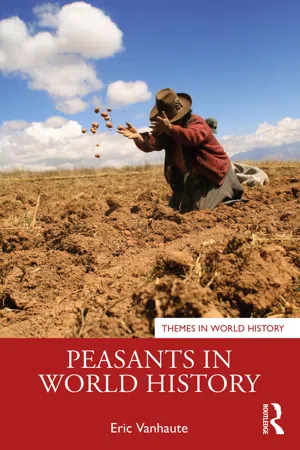
- 146 pages
- English
- ePUB (mobile friendly)
- Available on iOS & Android
Peasants in World History
About This Book
This is the first world history of peasants. Peasants in World History analyzes the multiple transformations of peasant life through history by focusing on three primary areas: the organization of peasant societies, their integration within wider societal structures, and the changing connections between local, regional and global processes.
Peasants have been a vital component in human history over the last 10, 000 years, with nearly one-third of the world's population still living a peasant lifestyle today. Their role as rural producers of ever-new surpluses instigated complex and often-opposing processes of social and spatial change throughout the world. Eric Vanhaute frames this social change in a story of evolving peasant frontiers. These frontiers provide a global comparative-historical lens to look at the social, economic and ecological changes within village-systems, agrarian empires and global capitalism. Bringing the story of the peasantry up through the modern period and looking to the future, the author offers a succinct overview with students in mind.
This book is recommended reading to anyone interested in the history and future of peasantries and is a valuable addition to undergraduate and graduate courses in World History, Global Economic History, Global Studies and Rural Sociology.
Frequently asked questions
1
Introduction
Recognizing also the past, present and future contributions of peasants and other people working in rural areas in all regions of the world to development and to conserving and improving biodiversity, which constitute the basis of food and agricultural production throughout the world, and their contribution in ensuring the right to adequate food and food security.
Peasant Worlds
Peasant Work
any person who engages or who seeks to engage, alone, or in association with others or as a community, in small-scale agricultural production for subsistence and/or for the market, and who relies significantly, though not necessarily exclusively, on family or household labor and other non-monetized ways of organizing labor, and who has a special dependency on and attachment to the land.
rural cultivators whose surpluses are transferred to a dominant group of rulers that uses the surpluses both to underwrite its own standard of living and to distribute the remainder to groups in society that do not farm but must be fed for their specific goods and services in return.
Peasant Communities and the Peasant Question
Table of contents
- Cover
- Half Title
- Series Page
- Title Page
- Copyright Page
- Dedication
- Table of Contents
- Acknowledgments
- 1 Introduction: The Peasant in Each of Us
- 2 New Frontiers: From the First Peasants to Early Agrarian States
- 3 Extending Frontiers: Agrarian Empires and Their Peasants
- 4 Interconnecting Frontiers: Imperial Growth, Commercial Expansion and the Peasantization of the World
- 5 Intensifying Frontiers: The Territorialization of Peasantries and the Final Enclosure
- 6 Globalizing Frontiers: The Reform of Peasantries in a Neoliberal World
- 7 The End of Frontiers: The Past and the Future of Peasants
- Index